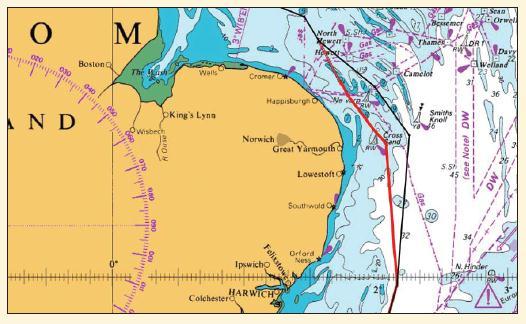200930 ECDIS-assisted grounding
Ecdis-assisted grounding
MARS Report 200930
Official report: Abridged from MAIB Report 21/2008

Recently a loaded dry cargo ship ran aground on Haisborough Sand off the east coast of England. The vessel quickly refloated without assistance and continued on passage to Grimsby, River Humber, where she arrived the following morning. There were no injuries or damage to the vessel, and there was no pollution.
The ship grounded 29 minutes after the OOW had adjusted course to follow an amended passage plan shown on the vessel's Ecdis. The route was hastily revised to ensure arrival at high water. This route took the vessel across Haisborough Sand, where the charted depth of water was considerably less than the vessel's draught.
Root cause/contributory factors
1. The deck officers had not been trained in the use of Ecdis and no procedures on the system's use were included in the vessel's SMS. They were, therefore, ignorant of many of the system requirements and features, operating the system in a very basic and inherently dangerous manner.
2. The route across Haisborough Sand was not adequately checked for navigational hazards, either when planned or when being monitored.
3. In-built safeguards in the Ecdis which are intended to prevent accidents of this nature were not utilised and system warnings were not acted upon.
4. The safety contour alarm did not sound as the vessel approached the shallow because a watch vector had not been set.
5. It is also highly likely that the configuration of the display was not optimised to clearly show the shallows over Haisborough Sand. At a scale of 1:100000 and with a safety contour of 30 m selected, the shallows over the bank were not readily apparent.
6. The OOW placed undue reliance on the Ecdis: it is possible that the grounding could have been avoided had he remained vigilant and continuously monitored the vessel's position in relation to navigational hazards.
Some of the pertinent deficiencies recorded by Port State Control at the destination port were:
1. The planned route took the vessel with a draught of 5.9 m across Haisborough Sand where the charted depth was less than 2 m.
2. The ship's navigating officers were not properly trained in the use of Ecdis.
3. The incident was not reported to the vessel's DPA for 23 hours.
4. The chart support certificate had expired.
Similar recent grounding accidents recorded by MAIB:
A cross-Channel ferry grounded after the helm was put the wrong way as the vessel approached a port entrance. This mistake was not noticed by the bridge team and, although an Ecdis was in use, no warning was given to indicate that the vessel was approaching shallow water because the watch vector, or predicted movement warning area, had not been correctly enabled.
A ro-ro ferry ran aground after the safety contour in her Ecdis was set at 30 m. This caused the chart display to be shaded blue, which severely impeded the bridge team's ability to see that the vessel was outside the navigable channel.
A ro-ro passenger ferry hit a submerged wreck near Dover and severely damaged her propellers. Although the vessel's primary means of navigation was paper charts, her deck officers relied on the vessel's ECS, despite not having been trained in its use. The wreck was not shown on the ECS display due to the settings applied to the system at the time.
Contributory factors to the grounding of a container ship in UK waters included lack of training in the use of the vessel's electronic chart system. This resulted in the use of inappropriate settings with regard to depth contours, and chart and depth alarms.
Foreseeing that Ecdis will replace paper charts as the primary planning and monitoring media on board most vessels over the next 10 years. MAIB has included the following in its recommendations:
1. A review of the content of the IMO model course syllabus for Ecdis.
2. As there can be significant differences between Ecdis models in terms of menus, terminology and equipment interface, shipowners must ensure that all bridge watchkeeping officers are familiar with navigation systems in use and they should use both generic and model specific training to meet this obligation.
3. Ships' crews are reminded of the need to ensure that all recorded information including VDR and ECDIS and other electronic data is preserved following an accident or incident.
The full pdf report is available and downloadable from www.maib.gov.uk/cms_resources/CFL_Performer.pdf
